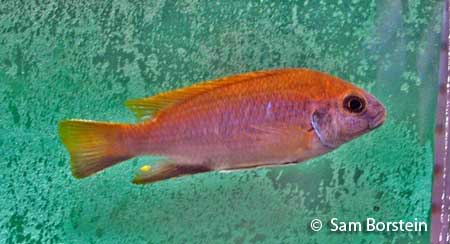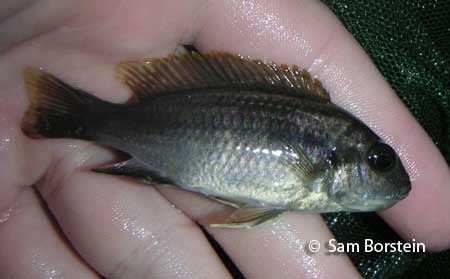Gephyrochromis lawsi
Fryer, 1957

Above: A male Gephyrochromis lawsi. Photo by Sam Borstein.
Etymology:
Genus- Gephyr= Bridge (Greek), Chromis= a fish, perhaps a Perch (Greek).
Intro:
Gephyrochromis lawsi is Lake Malawi mouthbrooder that was described by Fryer in 1957. Although this fish looks and acts like any member of the Pseudotropheus genus, scientists moved it into a new genus because of its thinner tooth structure.
Male Gephyrochromis lawsi are a vibrant purple with an orange blaze across their back. Females are relatively drab brown-gray, sometimes with a slight purple sheen.
Good looks and a mild disposition make Gephyrochromis lawsi an ideal fish for beginners in the cichlid hobby.Distribution:
Gephyrochromis lawsi is found in the northern part of Lake Malawi.
Size, Maturity, and Sexual Dimorphism:
Size: Males- 4 inches, Females- 3 inches
Maturity: 1.5 inches
Sexual Dimorphism: Males are larger than females and are a lot more colorful than the females which are brown.

Above: A holding female Gephyrochromis lawsi. Photo by Sam Borstein.
Care:
Gephyrochromis lawsi is easy to care for. Rocks should be added to the tank as hiding places and to give the fish a breeding surface. This fish is a peaceful mbuna. I never saw any form of aggression in these fish. You can keep this fish with some non-aggressive haps, or very peaceful mbuna.
Water conditions acceptable for this fish are a high pH and temperatures from 76F to 82F.
Diet:
This fish is carnivorous in the wild capturing crustaceans out of the sand but will eat anything in the aquarium. Mine did well on a diet of mixed flake and spectrum.
Breeding:
Gephyrochromis lawsi have the ability to breed like rats. This fish will spawn at anytime, anywhere, in any condition. I couldn't stop mine from spawning.
Breeding behavior is seems the same as Pseudotropheus. The females hold term well and for about 3 weeks. The fish can be difficult to strip the fry from, but I recommend that you separate fry from the female at about 18 days. At this point the fry should be close to free swimming and can start eating baby brine shrimp.
Conclusion:
This is an excellent mbuna to keep. The fish is peaceful and will add color to a tank. Don't expect to see this fish in the pet shop, but you may see it around in a local cichlid club.
References:
- Fryer, G. (1957) A new species of Gephyrochromis (Pisces: Cichlidae) from Lake Nyasa, with notes on its ecology and affinities. Revue de Zoologie et Botanique africaines, 55, 347-352.
- Konings, A. (2007) Malawi cichlids in their natural habitat. 4th ed., Cichlid Press, El Paso, Texas, 424 pp.
